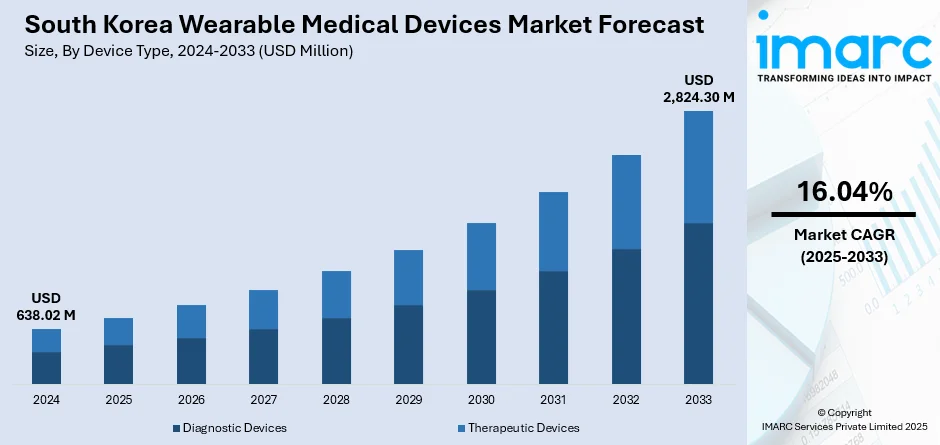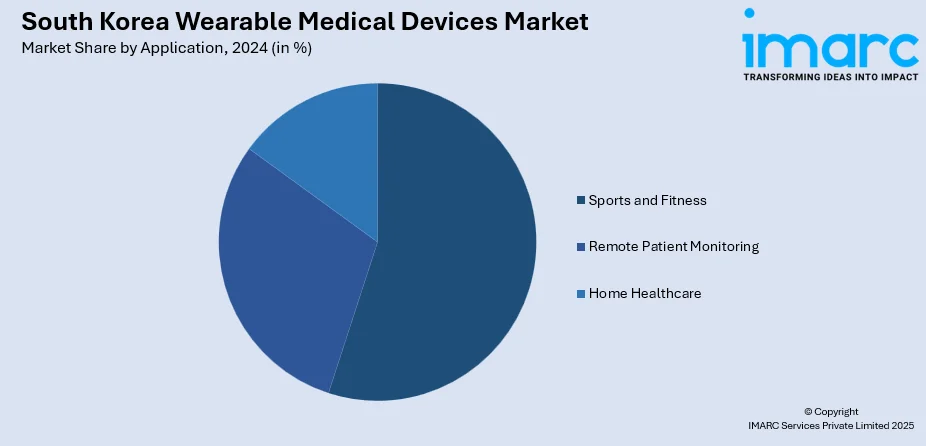
South Korea Wearable Medical Devices Market Size, Share, Trends and Forecast by Device Type, Product, Application, Distribution Channel, and Region, 2025-2033
South Korea Wearable Medical Devices Market Overview:
The South Korea wearable medical devices market size reached USD 638.02 Million in 2024. The market is projected to reach USD 2,824.30 Million by 2033, exhibiting a growth rate (CAGR) of 16.04% during 2025-2033. At present, the growing aging population is driving the demand for continuous health monitoring and easy-to-utilize healthcare solutions. Besides this, rising integration of artificial intelligence (AI), which aids in enhancing the functionality, accuracy, and user experience of products, is contributing to the expansion of the South Korea wearable medical devices market share.
|
Report Attribute
|
Key Statistics
|
|---|---|
|
Base Year
|
2024
|
|
Forecast Years
|
2025-2033
|
|
Historical Years
|
2019-2024
|
| Market Size in 2024 | USD 638.02 Million |
| Market Forecast in 2033 | USD 2,824.30 Million |
| Market Growth Rate 2025-2033 | 16.04% |
South Korea Wearable Medical Devices Market Trends:
Rising aging population
The growing aging population is positively influencing the market in South Korea. The South Korean Ministry of the Interior and Safety announced that in December 2024, South Korea entered a ‘super-aged’ society, as the percentage of its population aged 65 and older surpassed 20%. As the proportion of elderly individuals is rising, there is a greater need for managing chronic conditions, such as diabetes, hypertension, and cardiovascular diseases. Wearable medical devices, including smartwatches, fitness bands, and wearable electrocardiogram (ECG) monitors, offer non-invasive and real-time tracking of vital signs, enabling seniors to monitor their health conveniently at home. These devices support early detection of health issues and minimize the need for frequent hospital visits, which is especially important for aging individuals seeking independence and comfort. The aging population is also increasing the burden on the healthcare system, encouraging the shift towards preventive care and remote monitoring solutions. Family members and caregivers benefit from these devices as they can remotely track the well-being of elderly relatives, ensuring safety and timely intervention. Moreover, advancements in user-friendly designs and voice-assisted features are making wearable medical devices more accessible for older users. Government health initiatives and the growing insurance support for home-based care are further promoting the adoption of such technologies. As the senior population continues to expand in the country, wearable medical devices are becoming essential tools for improving quality of life.

To get more information on this market, Request Sample
Increasing utilization of AI
Rising adoption of AI is propelling the South Korea wearable medical devices market growth. As per the IMARC Group, the South Korea AI market size reached USD 3.12 Billion in 2024. AI enables wearable medical devices to analyze health data in real-time, offering personalized insights and early detection of health anomalies. These smart systems continuously learn from user behavior and vital sign trends, allowing more precise monitoring of conditions, such as heart rate, sleep patterns, blood pressure, and glucose levels. In South Korea’s tech-savvy population, AI-based devices are increasingly preferred for their ability to provide instant feedback, predictive alerts, and integration with digital health platforms. Healthcare providers benefit from AI by accessing detailed reports and trends, supporting more informed clinical decisions. People are also gaining confidence in managing their health independently through intuitive, AI-enhanced apps. As AI continues to evolve, its integration into wearable medical devices is supporting preventive healthcare and remote monitoring, decreasing hospital dependency. This technological advancement aligns well with South Korea’s digital health ambitions, further catalyzing the demand for smart, AI-oriented wearable solutions across the country.
South Korea Wearable Medical Devices Market Segmentation:
IMARC Group provides an analysis of the key trends in each segment of the market, along with forecasts at the country and regional levels for 2025-2033. Our report has categorized the market based on device type, product, application, and distribution channel.
Device Type Insights:
- Diagnostic Devices
- Vital Sign Monitoring Devices
- Sleep Monitoring Devices
- Electrocardiographs and Obstetric Devices
- Neuromonitoring Devices
- Therapeutic Devices
- Pain Management Devices
- Insulin Delivery Devices
- Rehabilitation Devices
- Respiratory Therapy Devices
The report has provided a detailed breakup and analysis of the market based on the device type. This includes diagnostic devices (vital sign monitoring devices, sleep monitoring devices, electrocardiographs and obstetric devices, and neuromonitoring devices) and therapeutic devices (pain management devices, insulin delivery devices, rehabilitation devices, and respiratory therapy devices).
Product Insights:
- Activity Monitors
- Smartwatches
- Patches
- Smart Clothing
- Hearing Aids
- Others
A detailed breakup and analysis of the market based on the product have also been provided in the report. This includes activity monitors, smartwatches, patches, smart clothing, hearing aids, and others.
Application Insights:

- Sports and Fitness
- Remote Patient Monitoring
- Home Healthcare
The report has provided a detailed breakup and analysis of the market based on the application. This includes sports and fitness, remote patient monitoring, and home healthcare.
Distribution Channel Insights:
- Offline
- Online
A detailed breakup and analysis of the market based on the distribution channel have also been provided in the report. This includes offline and online.
Regional Insights:
- Seoul Capital Area
- Yeongnam (Southeastern Region)
- Honam (Southwestern Region)
- Hoseo (Central Region)
- Others
The report has also provided a comprehensive analysis of all the major regional markets, which include Seoul Capital Area, Yeongnam (Southeastern Region), Honam (Southwestern Region), Hoseo (Central Region), and others.
Competitive Landscape:
The market research report has also provided a comprehensive analysis of the competitive landscape. Competitive analysis such as market structure, key player positioning, top winning strategies, competitive dashboard, and company evaluation quadrant has been covered in the report. Also, detailed profiles of all major companies have been provided.
South Korea Wearable Medical Devices Market News:
- In May 2025, Seers Technology introduced a wearable ECG for remote patient monitoring in South Korea. It made the complicated and bulky electrocardiogram easier to wear, allowing patients to use it all day comfortably. CEO Lee highlighted that Seers Technology's advantages were rooted in its integration of AI technology with manufacturing skills.
- In February 2025, Daewoong Pharmaceutical convened a meeting at JW Marriott Dongdaemun Square in South Korea to unveil its digital healthcare vision aimed at enhancing public health and to introduce thynC™, the first domestically produced digital device that secured insurance coverage for monitoring via remote heart technology. ThynC was a platform that aided healthcare professionals in constantly tracking patients' statuses and reacting promptly by employing wireless network technology and AI-enabled wearable diagnostic tools. The biosensor worn on the body captured biometric signals like electrocardiograms, temperature, and oxygen levels.
South Korea Wearable Medical Devices Market Report Coverage:
| Report Features | Details |
|---|---|
| Base Year of the Analysis | 2024 |
| Historical Period | 2019-2024 |
| Forecast Period | 2025-2033 |
| Units | Million USD |
| Scope of the Report |
Exploration of Historical Trends and Market Outlook, Industry Catalysts and Challenges, Segment-Wise Historical and Future Market Assessment:
|
| Device Types Covered |
|
| Products Covered | Activity Monitors, Smartwatches, Patches, Smart Clothing, Hearing Aids, Others |
| Applications Covered | Sports and Fitness, Remote Patient Monitoring, Home Healthcare |
| Distribution Channels Covered | Offline, Online |
| Regions Covered | Seoul Capital Area, Yeongnam (Southeastern Region), Honam (Southwestern Region), Hoseo (Central Region), Others |
| Customization Scope | 10% Free Customization |
| Post-Sale Analyst Support | 10-12 Weeks |
| Delivery Format | PDF and Excel through Email (We can also provide the editable version of the report in PPT/Word format on special request) |
Key Questions Answered in This Report:
- How has the South Korea wearable medical devices market performed so far and how will it perform in the coming years?
- What is the breakup of the South Korea wearable medical devices market on the basis of device type?
- What is the breakup of the South Korea wearable medical devices market on the basis of product?
- What is the breakup of the South Korea wearable medical devices market on the basis of application?
- What is the breakup of the South Korea wearable medical devices market on the basis of distribution channel?
- What is the breakup of the South Korea wearable medical devices market on the basis of region?
- What are the various stages in the value chain of the South Korea wearable medical devices market?
- What are the key driving factors and challenges in the South Korea wearable medical devices market?
- What is the structure of the South Korea wearable medical devices market and who are the key players?
- What is the degree of competition in the South Korea wearable medical devices market?
Key Benefits for Stakeholders:
- IMARC’s industry report offers a comprehensive quantitative analysis of various market segments, historical and current market trends, market forecasts, and dynamics of the South Korea wearable medical devices market from 2019-2033.
- The research report provides the latest information on the market drivers, challenges, and opportunities in the South Korea wearable medical devices market.
- Porter's five forces analysis assist stakeholders in assessing the impact of new entrants, competitive rivalry, supplier power, buyer power, and the threat of substitution. It helps stakeholders to analyze the level of competition within the South Korea wearable medical devices industry and its attractiveness.
- Competitive landscape allows stakeholders to understand their competitive environment and provides an insight into the current positions of key players in the market.
Need more help?
- Speak to our experienced analysts for insights on the current market scenarios.
- Include additional segments and countries to customize the report as per your requirement.
- Gain an unparalleled competitive advantage in your domain by understanding how to utilize the report and positively impacting your operations and revenue.
- For further assistance, please connect with our analysts.
 Request Customization
Request Customization
 Speak to an Analyst
Speak to an Analyst
 Request Brochure
Request Brochure
 Inquire Before Buying
Inquire Before Buying




.webp)




.webp)












